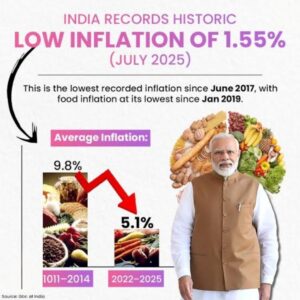India’s Retail Inflation Hits 8-Year Low at 1.5% : Why It Still Feels Expensive for Households ?
Retail Inflation Hits 8-Year Low at 1.5% : India’s July 2025 retail inflation, measured by the Consumer Price Index (CPI), has dropped to 1.5%, its lowest level in eight years.
Surprisingly, many households still feel the pinch of high living costs. This economic paradox has sparked debate: how can inflation be at historic lows when everyday expenses remain burdensome?
The Numbers of India’s Retail Inflation at a Glance
CPI (July 2025): 1.5% — down from 2.1% in June 2025.
Lowest since June 2017: when CPI stood at 1.46%.
Food inflation: –1.76% (negative growth).
Core inflation: Above 4% (excludes food and fuel).
RBI target range for Inflation: 2%–6%.
What is the CPI inflation and Why it Matters
The CPI measures the average change in prices paid by consumers for a basket of goods and services,
CPI includes,
- Food & beverages: 45% weight
- Housing: 10% weight
- Fuel & light: 6.8% weight
- Clothing & footwear: 6.5% weight
Unlike the Wholesale Price Index (WPI), which tracks prices at the wholesale level and only includes goods, the CPI includes both goods and services.
CPI inflation Data published monthly by the Ministry of Statistics and Programme Implementation and is a key tool for the Reserve Bank of India (RBI) in setting interest rates.

Why Inflation Has Dropped So Sharply and go to 8 years low
1. Food Prices Turn Negative
- Vegetables, pulses, cereals, sugar, eggs — all have seen price drops, pushing food inflation into negative territory.
- Given that food carries the highest weight in the CPI, this has had an outsized impact on the overall inflation figure.
2. Base Effect
- Inflation is measured year-on-year.
- In July 2024, food prices were unusually high (above 5%), creating a high base.
- Even with modest price increases in 2025, the percentage change appears small — a statistical phenomenon known as the base effect.
3. Seasonal Supply
- Better supply of perishables due to favorable harvests and smooth logistics has temporarily eased price pressures.
Headline vs. Core Inflation Debate
While headline CPI has plunged to 1.5%, core inflation — which excludes volatile food and fuel prices — remains above 4%.
This reflects persistent cost increases in:
- Healthcare
- Education
- Housing rents
These sectors are significant in household budgets and explain why consumers still feel stretched despite the CPI’s record low.
Beneficiaries and Losers of Low Retail Inflation
Winners who benifits from Low Inflation ,
- Borrowers: Falling inflation can lead to lower interest rates, reducing EMIs on home loans, car loans, and personal credit.
- Urban consumers: Lower food prices ease short-term spending pressure.
Losers due to Low Inflation,
- Farmers: Lower food prices hurt agricultural incomes, especially for smallholders relying on vegetable and grain sales.
- Rural economy: Reduced farm earnings can weaken rural demand for goods and services.
Why People Still Feel Prices are High
1. Persistent Core Inflation
- Costs in non-food essentials like education and healthcare continue rising faster than incomes.
2. Base Effect Illusion
- Price levels are already high compared to two years ago — a slower rate of increase does not mean prices have fallen significantly.
3. Changing Spending Patterns
- As household consumption shifts towards services (healthcare, education, technology), the benefits of falling food prices are less felt.

RBI’s Next Move amid Low Retail Inflation
The RBI kept its repo rate unchanged at 5.5% in its August Monetary Policy Committee (MPC) meeting.
However, if low inflation persists, the central bank may cut rates in its October review.
Potential impacts of a rate cut:
- Cheaper loans for consumers and businesses.
- Boost to investment and consumption.
- Risk of inflation rebound if demand overheats.
Risks Ahead on India’s Inflation Story
1. Monsoon Impact
- Poor rainfall could reduce crop yields, pushing food prices up later in the year.
2. Global Commodity Trends: Rising oil prices could lift fuel inflation.
3. Supply Disruptions: Any logistical bottlenecks can quickly reverse current gains.
Looking Beyond the Numbers of Retail Inflation
While an 8-year low in CPI inflation is headline-worthy, policymakers and households alike must focus on:
- Core inflation stability — to ensure real cost-of-living relief.
- Rural income protection — to avoid a slowdown in rural demand.
- Balanced price growth — preventing deflation in farm produce while keeping essentials affordable.
Key Takeaways from the Data of latest Retail Inflation in India
Retail inflation at 1.5% is driven mainly by falling food prices and last year’s high base.
Core inflation above 4% means non-food essentials remain costly.
Borrowers may benefit if RBI cuts interest rates in October, but farmers face income pressure.
Sustainable inflation control depends on stable food supply, strong rural demand, and manageable service sector price growth.
Final Words on India’s Retail Inflation Canvas
For now, the CPI’s drop signals welcome price stability in food, but the lived reality for many Indians — especially those facing rising education, healthcare, and housing costs — remains challenging. The next few months will be crucial to see if this is a one-off dip or the start of a long-term trend in taming inflation.
Read Also: Top 10 Highlights of PM Modi’s Speech at Red Fort on Independence day 2025
